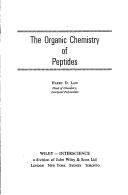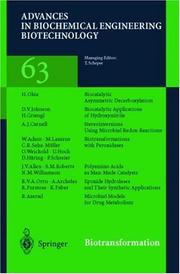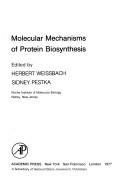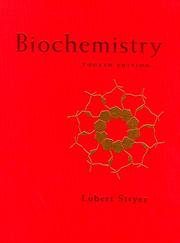| Listing 1 - 6 of 6 |
Sort by
|

ISBN: 0471518999 9780471518990 Year: 1970 Publisher: London : John Wiley,
Abstract | Keywords | Export | Availability | Bookmark
 Loading...
Loading...Choose an application
- Reference Manager
- EndNote
- RefWorks (Direct export to RefWorks)
Chemistry of natural organic substances --- Pharmacosynthesis. Pharmacochemistry --- Descriptive organic chemistry --- Peptides. --- Peptides --- PEPTIDES --- MOLECULAR STRUCTURE --- SYNTHESIS --- CHEMICAL ACTIONS --- BIOCHEMICAL MOLECULES --- PREPARATION

ISBN: 0897663810 0897663829 9780897663816 9780897663823 Year: 1987 Volume: 493 Publisher: New York, NY : New York Academy of Sciences,
Abstract | Keywords | Export | Availability | Bookmark
 Loading...
Loading...Choose an application
- Reference Manager
- EndNote
- RefWorks (Direct export to RefWorks)
Neuropathology --- Pathological endocrinology --- $ Secretory vesicles(Neuroendocrine-) --- Neuroendocrinology --- Neurotransmitters --- Congresses --- Congresses. --- Chemische bemiddelaren. (Congres) --- Neuro-endocrinologie. (Congrès) --- Médiateurs chimiques. (Congrès) --- Neuro-endocrinologie. (Congres) --- Neuroendocrinology - Congresses --- Neurotransmitters - Congresses --- BIOLOGICAL TRANSPORT --- BIOCHEMICAL MOLECULES --- MOLECULAR STRUCTURE --- PREPARATION

ISBN: 0306408937 1468441264 1468441248 9780306408939 Year: 1982 Volume: 41 Publisher: New York, NY ; London : Plenum Press,
Abstract | Keywords | Export | Availability | Bookmark
 Loading...
Loading...Choose an application
- Reference Manager
- EndNote
- RefWorks (Direct export to RefWorks)
Proteins --- Eukaryotic cells --- Synthesis --- Congresses --- -Proteins --- -Proteids --- Biomolecules --- Polypeptides --- Proteomics --- Eucaryotic cells --- Cells --- Protista --- -Congresses --- Congresses. --- Cells. --- Proteins - Synthesis - Congresses --- Eukaryotic cells - Congresses --- BIOCHEMICAL MOLECULES --- PROTEINS --- EUKARYOTES --- EUKARYOTIC CELLS --- PREPARATION

ISSN: 07246145 ISBN: 3540644962 9783540644965 3540697918 Year: 1999 Volume: 63 Publisher: Berlin : Springer-Verlag,
Abstract | Keywords | Export | Availability | Bookmark
 Loading...
Loading...Choose an application
- Reference Manager
- EndNote
- RefWorks (Direct export to RefWorks)
The use of enzymes – employed either as isolated enzymes, crude protein extracts or whole cells – for the transformation of non-natural organic c- pounds is not an invention of the twentieth century: they have been used for more than one hundred years. However,the object of most of the early research was totally different from that of the present day. Whereas the elucidation of biochemical pathways and enzyme mechanisms was the main driving force for the early studies,in contrast it was mainly during the 1980s that the enormous potential of applying natural catalysts to transform non-natural organic c- pounds was recognized. This trend was particularly well enhanced by the recommendation of the FDA-guidelines (1992) with respect to the use of chiral bioactive agents in enantiopure form. During the last two decades, it has been shown that the substrate tolerance of numerous biocatalysts is often much wider than previously believed. Of course,there are many enzymes which are very strictly bound to their natural substrate(s). They play an important role in metabolism and they are gener- ly not applicable for biotransformations. On the other hand, an impressive number of biocatalysts have been shown to possess a wide substrate tolerance by keeping their exquisite catalytic properties with respect to chemo-, reg- and, most important, enantio-selectivity. This made them into the key tools for biotransformations.
Activation [Metabolic ] --- Bioactivation (Metabolism) --- Biodegradation (Metabolism) --- Biotransformatie (Metabolisme) --- Biotransformation (Metabolism) --- Biotransformation (Metabolisme) --- Metrabolic activation --- Animal Physiology --- Biosynthèse --- Chemistry --- Biotechnology --- Chemistry, Organic --- Chemical engineering --- Enzymes --- Organic compounds --- Biotechnology. --- Synthesis. --- Organic chemistry. --- Biochemistry. --- Organic Chemistry. --- Biochemistry, general. --- Biological chemistry --- Chemical composition of organisms --- Organisms --- Physiological chemistry --- Biology --- Medical sciences --- Genetic engineering --- Organic chemistry --- Composition --- Enzymes - Biotechnology. --- Organic compounds - Synthesis. --- BIOCHEMICAL MOLECULES --- ENZYMES --- CATALYSIS --- REACTIONS

ISBN: 0127442502 9780127442501 Year: 1977 Publisher: New York, NY : Academic Press,
Abstract | Keywords | Export | Availability | Bookmark
 Loading...
Loading...Choose an application
- Reference Manager
- EndNote
- RefWorks (Direct export to RefWorks)
Molecular biology --- Chemistry of natural organic substances --- Genetics, Biochemical --- Proteins --- Protéines --- Biologie moléculaire --- congresses --- Synthesis --- Synthèse --- Molecular Biology. --- Synthesis. --- -Proteids --- Biomolecules --- Polypeptides --- Proteomics --- Molecular biochemistry --- Molecular biophysics --- Biochemistry --- Biophysics --- Systems biology --- Biochemical Genetics --- Biology, Molecular --- Genetics, Molecular --- Molecular Genetics --- Biochemical Genetic --- Genetic, Biochemical --- Genetic, Molecular --- Molecular Genetic --- Molecular biology. --- Congresses. --- Genetic Phenomena --- -Synthesis --- Molecular Biology --- Protein biosynthesis --- Protein synthesis --- Metabolism --- Proteins - Synthesis. --- Genetics, Biochemical - congresses --- RNA --- PROTEINS --- BIOCHEMICAL MOLECULES --- RIBOSOMES --- GENETICS --- PREPARATION

ISBN: 0716720094 9780716720096 Year: 1995 Publisher: New York Freeman
Abstract | Keywords | Export | Availability | Bookmark
 Loading...
Loading...Choose an application
- Reference Manager
- EndNote
- RefWorks (Direct export to RefWorks)
immunoglobulines --- Métabolisme des protéines --- Métabolisme énergétique --- Biosynthèse --- Cellule d'eucaryote --- eukaryotic cells --- Biochemistry --- 577.1 --- Biochemie --- #WPLT:kand --- Biological chemistry --- Chemical composition of organisms --- Organisms --- Physiological chemistry --- Biology --- Chemistry --- Medical sciences --- 577.1 Chemical bases of life. Biochemistry and bio-organic chemistry generally --- Chemical bases of life. Biochemistry and bio-organic chemistry generally --- Composition --- biochemie --- General biochemistry --- biochemistry --- proteïnen --- Biochemistry. --- proteins --- Protein metabolism --- Energy metabolism --- Biosynthesis --- genes --- gene expression --- ARN --- RNA --- genetic engineering --- Biochimie --- RNA. --- BIOCHEMISTRY --- Monograph --- Structure moleculaire --- MOLECULAR BIOLOGY --- PROTEINS --- METABOLISM --- GENES --- BIOCHEMICAL MOLECULES --- TEXTBOOKS --- PROPERTIES --- PREPARATION
| Listing 1 - 6 of 6 |
Sort by
|

 Search
Search Feedback
Feedback About UniCat
About UniCat  Help
Help News
News